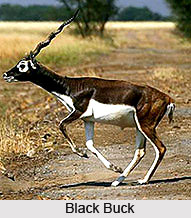 The Indian Black Buck is known by several names like KalaHiran, Sasin, Iralai Maan and Krishna Jinka. Antilope cervicapra as it is scientifically called is based in the Indian subcontinent. The average lifespan of the Indian Black Buck is twelve years, which can extend to sixteen years. They are the preys of the dogs and wolves.
The Indian Black Buck is known by several names like KalaHiran, Sasin, Iralai Maan and Krishna Jinka. Antilope cervicapra as it is scientifically called is based in the Indian subcontinent. The average lifespan of the Indian Black Buck is twelve years, which can extend to sixteen years. They are the preys of the dogs and wolves.
The male black buck is nearly thirty-two inches in height and weighs about seventy to ninety -five pounds. The upper part of the body is covered with dark brown or black fur while the chest, belly, inner sides of the legs muzzle and chin of the males have white fur. Even the regions near the eyes have white circles. The male black bucks have ringed horns, which can be as long as twenty-eight meters in length and can bend with three or four turns. The young male bucks are light brown in colour but as they grow up nearly three years of age hey turn dark brown or black in colour.
The female black bucks are smaller in size than their male counterparts. They are beige or light brown in colour and in most cases the female black bucks do not have horns. Even those female black bucks that have horn they lack the rings and spirals, which their male counterparts have. Sharp eyesight and speed are the defense mechanisms that the black buck employs against the predators. The female black bucks have a gestation period of nearly five months and they give birth to two fawns every year with a gap of six months.
The fawn of the black buck joins the group only after two weeks. They are gregarious animal and rarely do they live in isolation. Their group comprises of fifteen to twenty members and can be a female group, mixed group, bachelor group or territorial males. The group of the territorial male dominates the other groups and lives in the main grazing areas.
In India, the black bucks are found nearly everywhere except in the northeastern regions. The open plains of India are their natural habitat and they are considered the fastest running animals in the world. They love on open grasslands, dry thorn and scrublands. Grass is the principal food of the Indian Black Buck although they also eat pods, flowers and fruits.



















